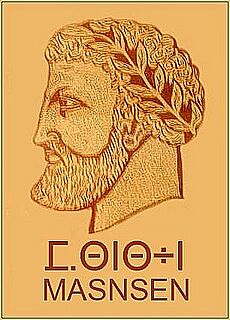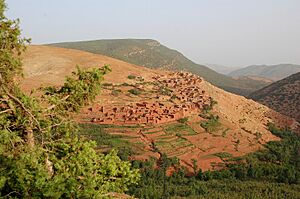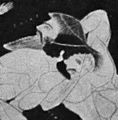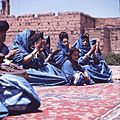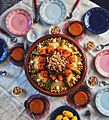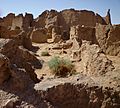Berbers facts for kids
- Berbers
- Amazighs
Quick facts for kids Imaziɣenأمازيغ |
|
|---|---|
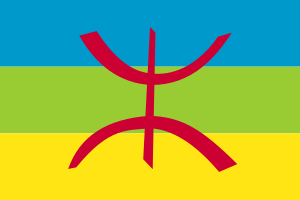
The Berber ethnic flag
|
|
| Total population | |
| 36 million | |
| Regions with significant populations | |
| Morocco | 15 million to 20 million |
| Algeria | 9 million to ~13 million |
| Niger | 2.6 million |
| France | 2 million |
| Mali | 850,000 |
| Libya | 600,000 |
| Belgium | 500,000 |
| Netherlands | 467,455 |
| Burkina Faso | 406,271 |
| Tunisia | 173,937 |
| Mauritania | 133,000 |
| Canada | 37,060 (including those of mixed ancestry) |
| Egypt | 23,000 |
| Norway | 4,500 |
| Israel | 3,500 |
| United States | 1,325 |
| Languages | |
| Berber languages (Tamazight) and Arabic | |
| Religion | |
| Predominantly Sunni Islam. Minorities Ibadis, Shias, Christianity (chiefly Catholicism), Judaism |
|
| Related ethnic groups | |
| Arabs and other Afro-Asiatic speaking Mediterranean peoples | |
The Berbers, also known as Amazigh or Imazighen, are a group of people native to North Africa. They lived in this region long before the arrival of Arabs. Their main connection is the Berber languages they speak, which are part of the Afroasiatic language family.
Berbers live in scattered communities across parts of Morocco, Algeria, Libya, and to a lesser extent Tunisia, Mauritania, northern Mali and northern Niger. Smaller groups are also found in Burkina Faso and Egypt's Siwa Oasis.
The Imazighen are descended from ancient tribes of North Africa. They were first mentioned in Ancient Egyptian writings around 2000 BCE. Over time, Berber languages spread from the Nile Valley across the northern Sahara. Various Berber kingdoms, like Numidia and Mauretania, rose and fell.
In the 7th and 8th centuries CE, Arab armies arrived in North Africa. This led to a process called Arabization, where the Arabic language and Arab culture spread among the Berbers. Many Berbers adopted Arabic as their main language and converted to Islam. Despite this, Berber tribes remained strong and even founded new ruling families, like the Almoravids and Almohads, who built large empires between the 11th and 13th centuries.
Today, the term "Berber" is sometimes seen as old-fashioned by many who prefer "Amazigh." A movement called Berberism has grown to promote a shared Amazigh ethnic identity and to gain more rights for their languages and culture.
Contents
Understanding the Berbers
What does "Amazigh" mean?
The native people of the Maghreb region in North Africa are called Berbers or Amazigh. The word "Berber" comes from ancient times, possibly from Egyptian inscriptions. However, many people prefer "Amazigh" because "Berber" can sound like "barbarian" in Arabic.
Historically, different Berber groups had their own names for themselves. For example, the Kabyles called themselves "Leqbayel." The word "Amazigh" might mean "noble" or "free," and it is related to the Tuareg word "Amajegh," which also means noble.
Where do Berbers come from?
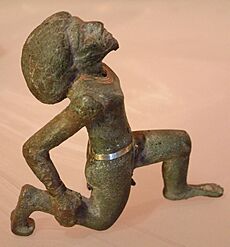
Scientists believe that Berbers have lived in the Maghreb region since at least 10,000 BC. Ancient cave paintings found in places like Tassili n'Ajjer in Algeria show early life in the Sahara. Around 6000 to 2000 BC, people in North Africa started farming and raising animals.
Ancient writings from Egypt and Rome mention groups like the Mauri, Numidians, and Libu, who are thought to be ancestors of today's Berbers. DNA studies also show that modern Berbers are mostly descended from these ancient North African populations.
A Look at Berber History
Ancient Berber Kingdoms
In ancient times, the Berbers were known as ancient Libyans. Major tribes included the Mauri in the west (modern Morocco and Algeria) and the Numidians near Carthage (modern Tunisia). These groups lived in villages, farmed, and raised animals. The Gaetulians lived to the south, closer to the Sahara, and were more nomadic.
The Phoenicians, who were skilled traders from the Middle East, set up trading posts along the North African coast. Eventually, these grew into cities like Carthage. While the Phoenicians were powerful, some Berber kingdoms, like Numidia, were strong enough to demand tribute from Carthage.
Numidia: A Powerful Kingdom
Numidia was an important ancient Berber kingdom in modern Algeria and Tunisia. It was known for its skilled horse riders. One of its most famous kings was Masinissa (around 240–148 BC). He allied with the Romans against Carthage in the Second Punic War. After the Roman victory, Masinissa's kingdom grew to cover a large area.
Numidia later became a Roman province. Many Berbers continued to live in the region, sometimes clashing with Roman rule. Some famous figures from this era, like the writer Apuleius and the Christian saint St. Augustine, were born in Numidia.
The Arrival of Islam

In the 7th and 8th centuries, Arab armies brought Islam to North Africa. This new religion spread widely among the Berbers. However, the ruling Arabs sometimes treated Berber converts unfairly, leading to revolts. One famous Berber leader was Dihya, a queen who led resistance against the Arab conquest.
Despite early conflicts, many Berbers became Muslim. They even played a key role in the Muslim conquest of the Iberian Peninsula (modern Spain and Portugal) in 711, led by the Berber general Tariq ibn Ziyad.
Berber Empires in the Middle Ages

During the Middle Ages, several powerful Berber ruling families emerged in North Africa and al-Andalus (Muslim Spain). These included the Zirids, Hammadids, Almoravids, and Almohads.
The Almoravids and Almohads built large empires that stretched across North Africa and into Spain. They were known for their strong armies and for promoting Islamic learning and culture. Their rule significantly shaped the history and architecture of the region. Later Berber dynasties like the Marinids and Hafsids continued to rule until the 16th century.
Modern Times
In modern history, many Berber communities, especially in mountainous areas like the Kabylia region of Algeria, remained independent for a long time, even during the rule of the Ottoman Empire.
During the colonial period, European powers like France and Spain took control of North Africa. The Rif Berbers in Morocco, led by Abd el-Krim, famously rebelled against Spanish rule in the 1920s.
After North African countries gained independence in the mid-20th century, Arabic became the official language. This meant that Berber languages were not taught in schools for a long time. This led to the rise of the Berberism movement, which seeks to protect and promote Berber languages and culture. Today, Berber languages are recognized as official languages in Morocco and Algeria.
Berber Life and Culture
Berber Languages
The Berber languages are called Tamazight as a general name. There are many different varieties and dialects, like Riffian, Kabyle, Shilha, and Tamasheq (spoken by the Tuareg).
Most Berbers also speak Arabic and French. Berber languages have borrowed many words from Arabic over time. In turn, Berber languages have also influenced local dialects of Arabic. Around 14 to 16 million people in Africa speak Berber languages today.
Religion and Beliefs

Most Berbers today are Sunni Muslims. However, some groups, like the Mozabites in Algeria and some Libyan Berbers, follow Ibadi Islam, which is a different branch of Islam.
Before Islam, Berbers had their own traditional beliefs, which included respecting ancestors and nature spirits. These beliefs were also influenced by ancient Egyptian, Punic, and Roman religions. Some of these old traditions still exist in Berber culture today.
There was also a significant Jewish Berber minority in Morocco until the 1960s, when most moved to Israel or France. In recent years, some Berbers have converted to Christianity.
Social Life and Traditions
Berber society has traditionally been organized into tribes, each with its own leader. While most tribes are led by men today, historically, some powerful Berber women leaders existed, like Dihya and Lalla Fatma N'Soumer, who fought against the French.
In some Berber cultures, like the Tuareg, women have a special role and may even choose their future husbands. Marriage traditions vary greatly between different tribes.
Traditionally, men often take care of livestock and move with their herds to find grazing land. Women usually manage the household and create beautiful handicrafts, like woven carpets and jewelry, often for sale in local markets.
Arts and Crafts
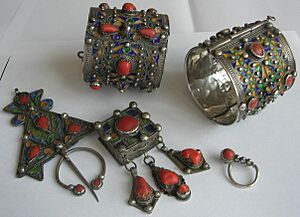
Berber tribes are famous for weaving kilims, which are tapestry-woven carpets. Each tribe has its own unique designs, often featuring stripes and geometric shapes like triangles and diamonds.
Traditional Berber jewelry is another beautiful art form, usually made of silver. These pieces, like elaborate pins and bracelets, were originally worn by women and girls. Today, they are also popular as ethnic-style fashion items.
Berber art also includes ancient Tifinagh scripts and unique calendar designs.
Delicious Berber Food

Berber cuisine is rich in tradition and varies across different regions. Some of the most famous Berber foods include:
- Couscous: A staple dish made from tiny balls of semolina.
- Tajine: A slow-cooked stew prepared in a special clay pot with a cone-shaped lid.
- Pastilla: A savory meat pie, traditionally made with pigeon, but often with chicken today.
- Bouchiar: Thin, yeastless wafers soaked in butter and honey.
- Baghrir: Light, spongy pancakes, often served hot with butter and honey.
These traditional foods reflect the long history and unique culture of the Berber people.
Images for kids
-
A faience tile from the throne of Pharaoh Ramesses III depicting a tattooed ancient Libyan chief c. 1184 to 1153 BC
-
Ancient Libyan delegation at Persepolis
-
Heracles wrestling with the Libyan giant Antaeus
-
Fernández de Lugo presenting the captured Guanche kings of Tenerife to Ferdinand and Isabella, 1497
-
Castillian ambassadors meeting Almohad caliph Abu Hafs Umar al-Murtada, contemporary depiction from the Cantigas de Santa Maria
-
An old Amazigh room in Morocco
-
Old fortress at Calatrava la Vieja. The site was used during the Muslim period from about 785 until the fall of the Caliphate of Cordova.
-
Mauretanian cavalry under Lusius Quietus fighting in the Dacian wars, from the Column of Trajan
-
Abd el-Krim featured in the magazine Time in 1925
-
Sanhaja Berber women in the 1970s
-
Berber village in the Atlas mountains
-
Berber henna decoration
-
Algerian Berber calendar
-
Turkey tajine
-
Remains of Germa, a capital of the Garamantes (first millennium BC)
-
Numidian tomb of Medracen (c. 200-150 BC)
-
The Kutubiyya Mosque in Marrakesh, built by the Almohads in the 12th century
-
The ksar of Aït Benhaddou in Morocco
See also
 In Spanish: Bereberes para niños
In Spanish: Bereberes para niños
- Hamites
- Haratin
- Maghrebis




